Factors Impacting Sales Performance of Hotels in Victoria, Australia
VerifiedAdded on 2020/03/16
|22
|3815
|183
Project
AI Summary
This project proposal examines the factors affecting sales performance of hotels and restaurants in Victoria, Australia. It investigates both internal and external factors influencing business success, including customer preferences, competition, and the state of the economy. The study aims to identify the impact of organizational branding, customer service, and human resource management on sales. The research design incorporates both qualitative and quantitative methods, including interviews and questionnaires, to gather data from employees, managers, and customers. The project will analyze the collected data to understand the relationships between various factors and sales performance, offering insights into how hotels and restaurants can improve their business outcomes through strategies such as customer relationship management, innovation, and employee loyalty programs. The study also explores the importance of customer satisfaction, human resources, and organizational branding. The project concludes with a discussion of the research limitations and a proposed time schedule for completion.
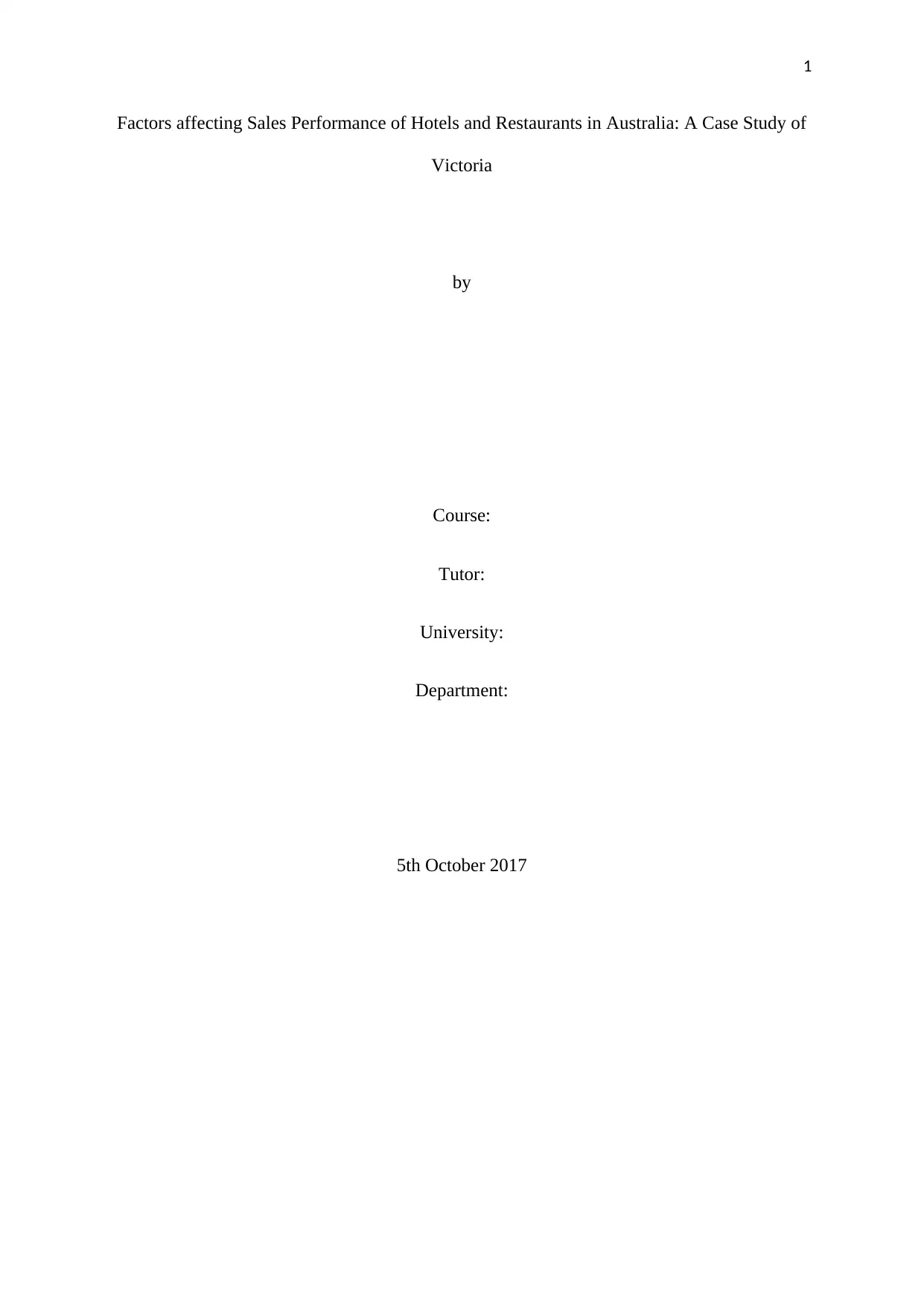
1
Factors affecting Sales Performance of Hotels and Restaurants in Australia: A Case Study of
Victoria
by
Course:
Tutor:
University:
Department:
5th October 2017
Factors affecting Sales Performance of Hotels and Restaurants in Australia: A Case Study of
Victoria
by
Course:
Tutor:
University:
Department:
5th October 2017
Paraphrase This Document
Need a fresh take? Get an instant paraphrase of this document with our AI Paraphraser
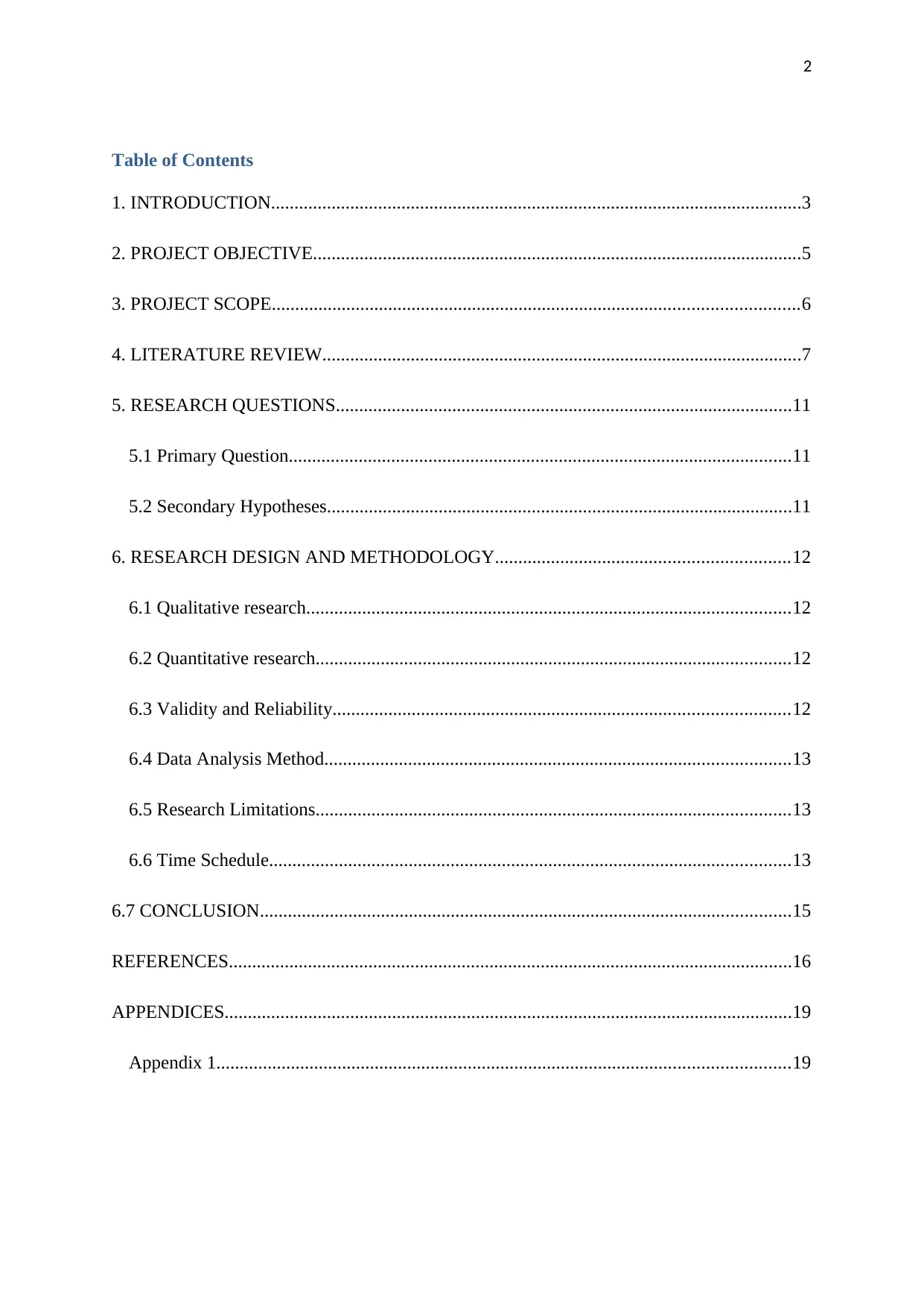
2
Table of Contents
1. INTRODUCTION..................................................................................................................3
2. PROJECT OBJECTIVE.........................................................................................................5
3. PROJECT SCOPE.................................................................................................................6
4. LITERATURE REVIEW.......................................................................................................7
5. RESEARCH QUESTIONS..................................................................................................11
5.1 Primary Question............................................................................................................11
5.2 Secondary Hypotheses....................................................................................................11
6. RESEARCH DESIGN AND METHODOLOGY...............................................................12
6.1 Qualitative research........................................................................................................12
6.2 Quantitative research......................................................................................................12
6.3 Validity and Reliability..................................................................................................12
6.4 Data Analysis Method....................................................................................................13
6.5 Research Limitations......................................................................................................13
6.6 Time Schedule................................................................................................................13
6.7 CONCLUSION..................................................................................................................15
REFERENCES.........................................................................................................................16
APPENDICES..........................................................................................................................19
Appendix 1...........................................................................................................................19
Table of Contents
1. INTRODUCTION..................................................................................................................3
2. PROJECT OBJECTIVE.........................................................................................................5
3. PROJECT SCOPE.................................................................................................................6
4. LITERATURE REVIEW.......................................................................................................7
5. RESEARCH QUESTIONS..................................................................................................11
5.1 Primary Question............................................................................................................11
5.2 Secondary Hypotheses....................................................................................................11
6. RESEARCH DESIGN AND METHODOLOGY...............................................................12
6.1 Qualitative research........................................................................................................12
6.2 Quantitative research......................................................................................................12
6.3 Validity and Reliability..................................................................................................12
6.4 Data Analysis Method....................................................................................................13
6.5 Research Limitations......................................................................................................13
6.6 Time Schedule................................................................................................................13
6.7 CONCLUSION..................................................................................................................15
REFERENCES.........................................................................................................................16
APPENDICES..........................................................................................................................19
Appendix 1...........................................................................................................................19
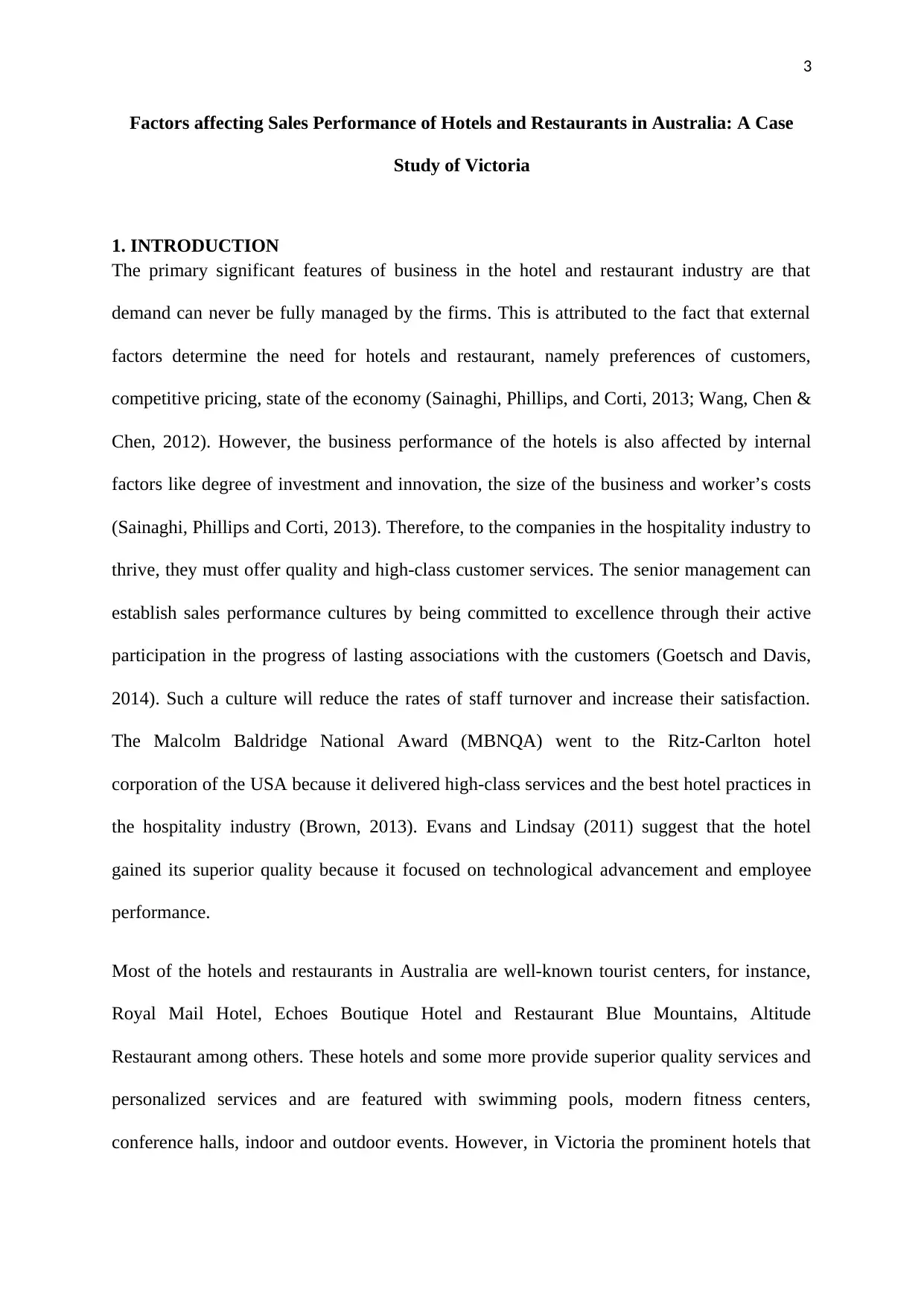
3
Factors affecting Sales Performance of Hotels and Restaurants in Australia: A Case
Study of Victoria
1. INTRODUCTION
The primary significant features of business in the hotel and restaurant industry are that
demand can never be fully managed by the firms. This is attributed to the fact that external
factors determine the need for hotels and restaurant, namely preferences of customers,
competitive pricing, state of the economy (Sainaghi, Phillips, and Corti, 2013; Wang, Chen &
Chen, 2012). However, the business performance of the hotels is also affected by internal
factors like degree of investment and innovation, the size of the business and worker’s costs
(Sainaghi, Phillips and Corti, 2013). Therefore, to the companies in the hospitality industry to
thrive, they must offer quality and high-class customer services. The senior management can
establish sales performance cultures by being committed to excellence through their active
participation in the progress of lasting associations with the customers (Goetsch and Davis,
2014). Such a culture will reduce the rates of staff turnover and increase their satisfaction.
The Malcolm Baldridge National Award (MBNQA) went to the Ritz-Carlton hotel
corporation of the USA because it delivered high-class services and the best hotel practices in
the hospitality industry (Brown, 2013). Evans and Lindsay (2011) suggest that the hotel
gained its superior quality because it focused on technological advancement and employee
performance.
Most of the hotels and restaurants in Australia are well-known tourist centers, for instance,
Royal Mail Hotel, Echoes Boutique Hotel and Restaurant Blue Mountains, Altitude
Restaurant among others. These hotels and some more provide superior quality services and
personalized services and are featured with swimming pools, modern fitness centers,
conference halls, indoor and outdoor events. However, in Victoria the prominent hotels that
Factors affecting Sales Performance of Hotels and Restaurants in Australia: A Case
Study of Victoria
1. INTRODUCTION
The primary significant features of business in the hotel and restaurant industry are that
demand can never be fully managed by the firms. This is attributed to the fact that external
factors determine the need for hotels and restaurant, namely preferences of customers,
competitive pricing, state of the economy (Sainaghi, Phillips, and Corti, 2013; Wang, Chen &
Chen, 2012). However, the business performance of the hotels is also affected by internal
factors like degree of investment and innovation, the size of the business and worker’s costs
(Sainaghi, Phillips and Corti, 2013). Therefore, to the companies in the hospitality industry to
thrive, they must offer quality and high-class customer services. The senior management can
establish sales performance cultures by being committed to excellence through their active
participation in the progress of lasting associations with the customers (Goetsch and Davis,
2014). Such a culture will reduce the rates of staff turnover and increase their satisfaction.
The Malcolm Baldridge National Award (MBNQA) went to the Ritz-Carlton hotel
corporation of the USA because it delivered high-class services and the best hotel practices in
the hospitality industry (Brown, 2013). Evans and Lindsay (2011) suggest that the hotel
gained its superior quality because it focused on technological advancement and employee
performance.
Most of the hotels and restaurants in Australia are well-known tourist centers, for instance,
Royal Mail Hotel, Echoes Boutique Hotel and Restaurant Blue Mountains, Altitude
Restaurant among others. These hotels and some more provide superior quality services and
personalized services and are featured with swimming pools, modern fitness centers,
conference halls, indoor and outdoor events. However, in Victoria the prominent hotels that
⊘ This is a preview!⊘
Do you want full access?
Subscribe today to unlock all pages.

Trusted by 1+ million students worldwide
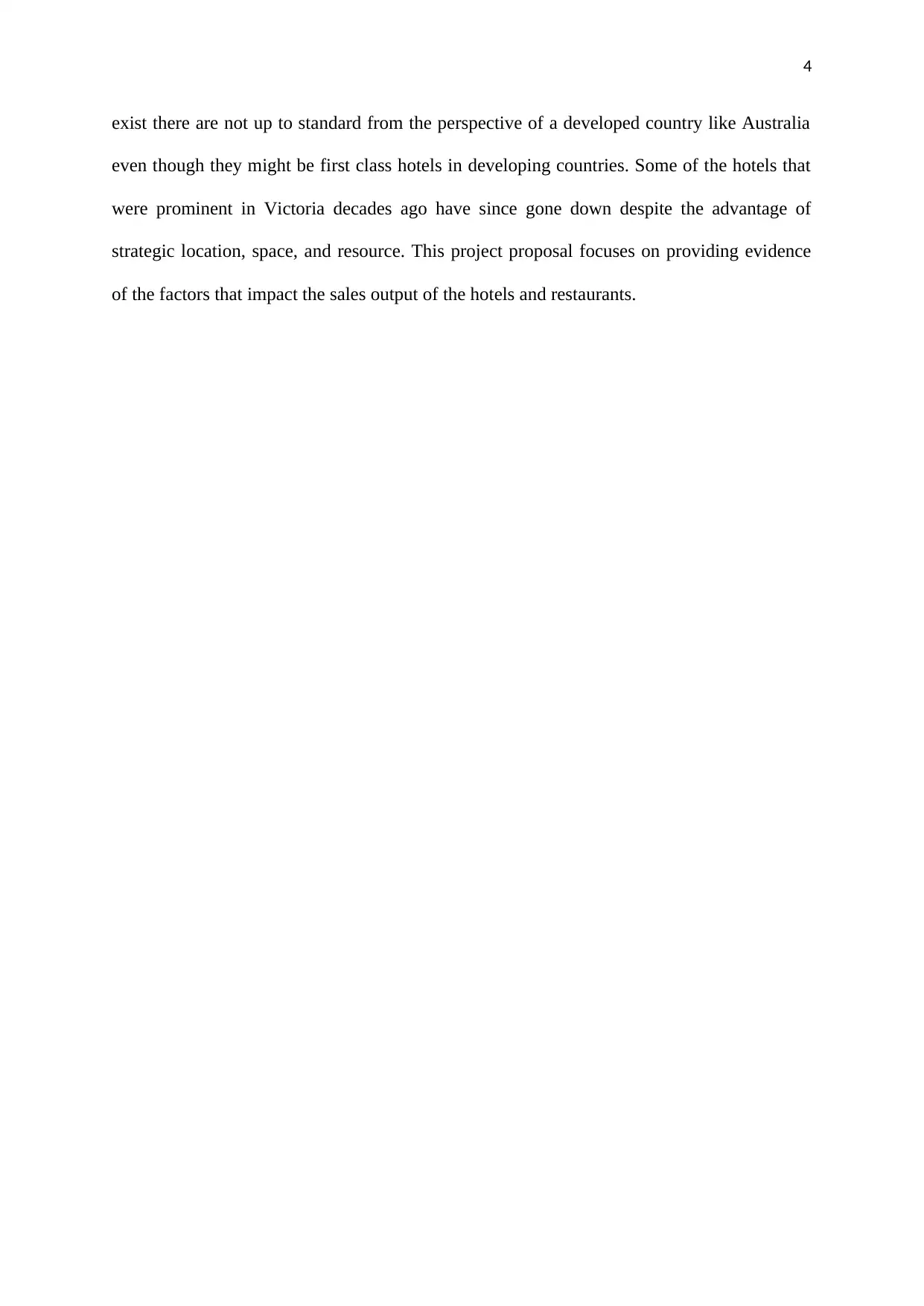
4
exist there are not up to standard from the perspective of a developed country like Australia
even though they might be first class hotels in developing countries. Some of the hotels that
were prominent in Victoria decades ago have since gone down despite the advantage of
strategic location, space, and resource. This project proposal focuses on providing evidence
of the factors that impact the sales output of the hotels and restaurants.
exist there are not up to standard from the perspective of a developed country like Australia
even though they might be first class hotels in developing countries. Some of the hotels that
were prominent in Victoria decades ago have since gone down despite the advantage of
strategic location, space, and resource. This project proposal focuses on providing evidence
of the factors that impact the sales output of the hotels and restaurants.
Paraphrase This Document
Need a fresh take? Get an instant paraphrase of this document with our AI Paraphraser
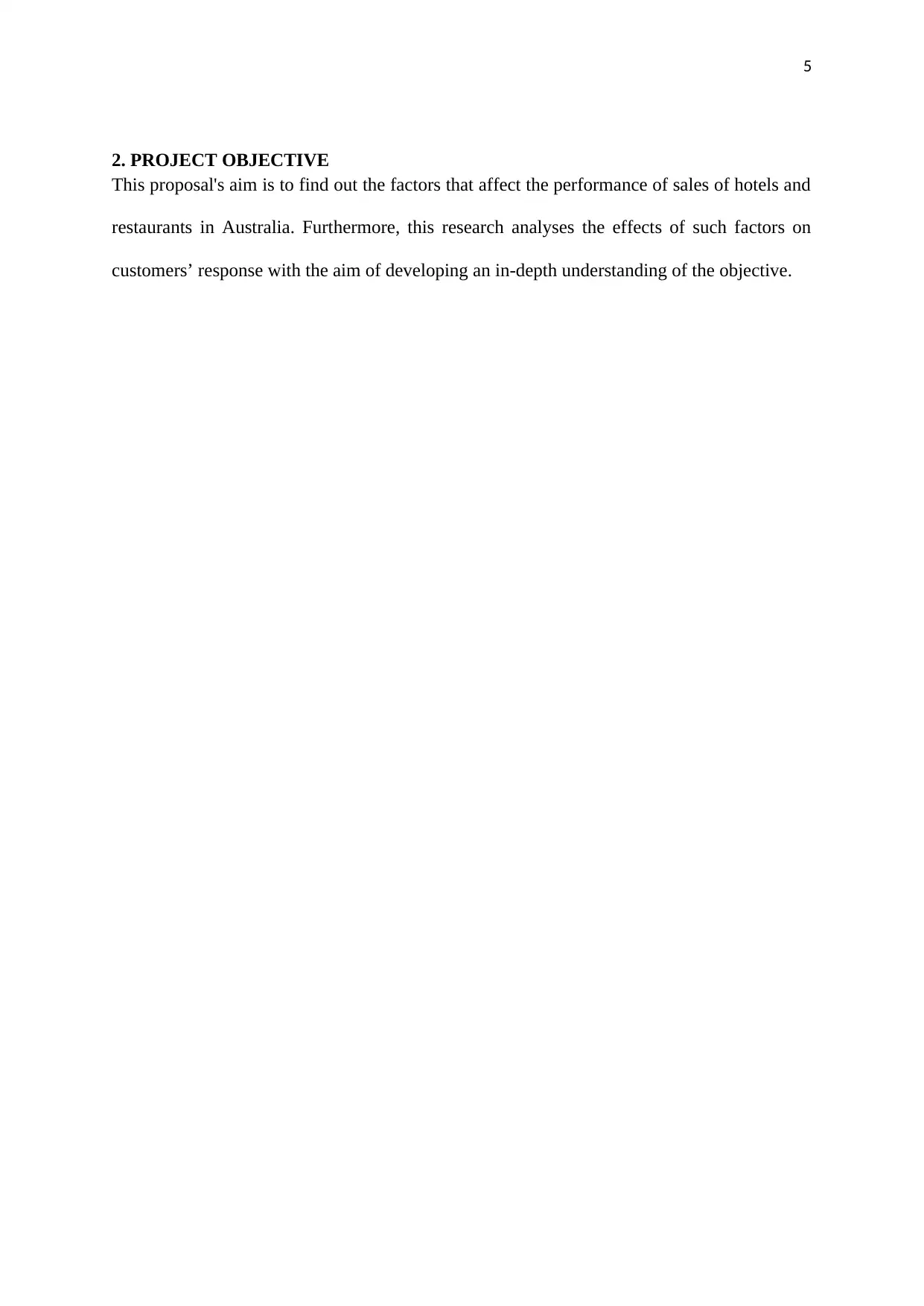
5
2. PROJECT OBJECTIVE
This proposal's aim is to find out the factors that affect the performance of sales of hotels and
restaurants in Australia. Furthermore, this research analyses the effects of such factors on
customers’ response with the aim of developing an in-depth understanding of the objective.
2. PROJECT OBJECTIVE
This proposal's aim is to find out the factors that affect the performance of sales of hotels and
restaurants in Australia. Furthermore, this research analyses the effects of such factors on
customers’ response with the aim of developing an in-depth understanding of the objective.
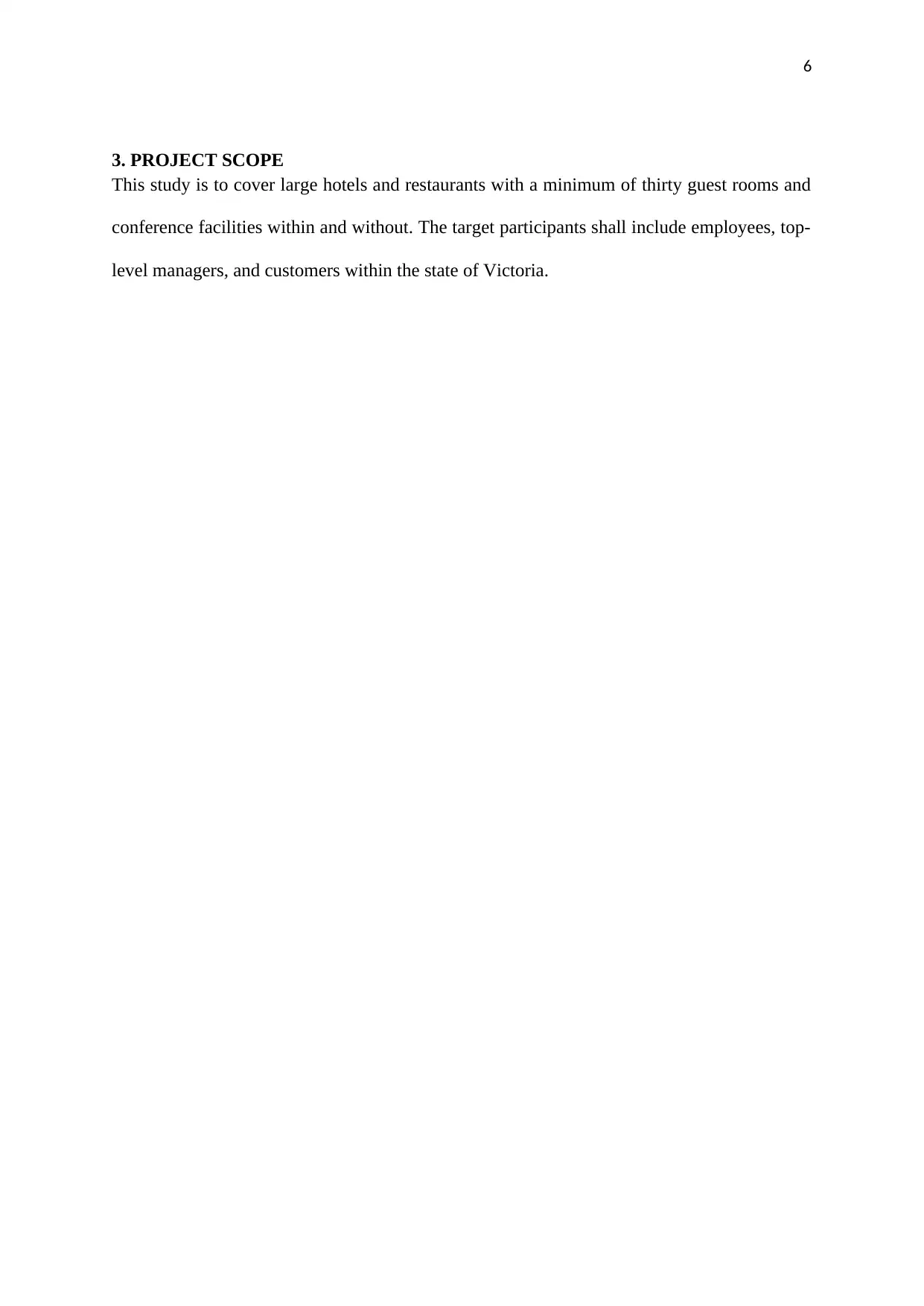
6
3. PROJECT SCOPE
This study is to cover large hotels and restaurants with a minimum of thirty guest rooms and
conference facilities within and without. The target participants shall include employees, top-
level managers, and customers within the state of Victoria.
3. PROJECT SCOPE
This study is to cover large hotels and restaurants with a minimum of thirty guest rooms and
conference facilities within and without. The target participants shall include employees, top-
level managers, and customers within the state of Victoria.
⊘ This is a preview!⊘
Do you want full access?
Subscribe today to unlock all pages.

Trusted by 1+ million students worldwide
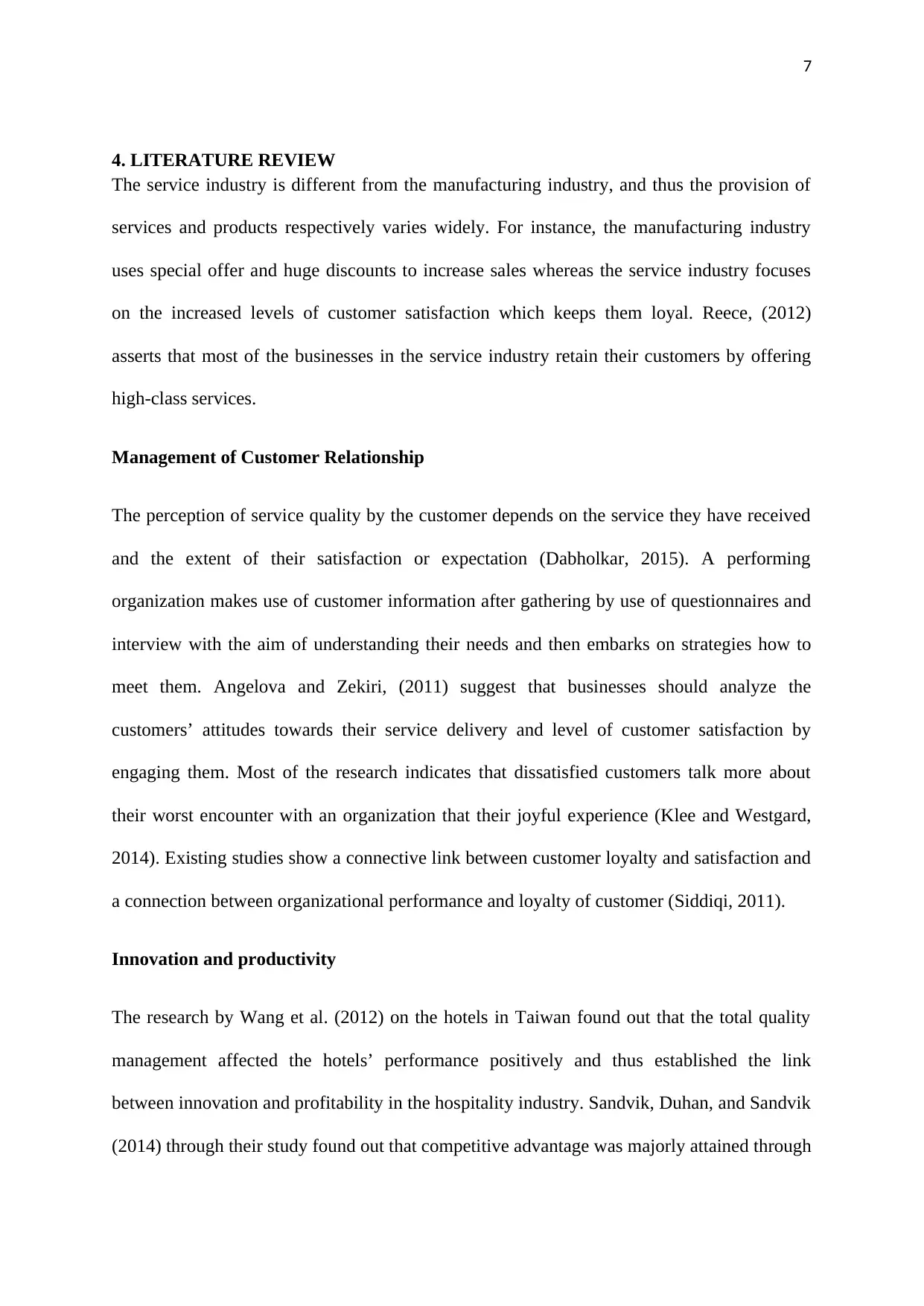
7
4. LITERATURE REVIEW
The service industry is different from the manufacturing industry, and thus the provision of
services and products respectively varies widely. For instance, the manufacturing industry
uses special offer and huge discounts to increase sales whereas the service industry focuses
on the increased levels of customer satisfaction which keeps them loyal. Reece, (2012)
asserts that most of the businesses in the service industry retain their customers by offering
high-class services.
Management of Customer Relationship
The perception of service quality by the customer depends on the service they have received
and the extent of their satisfaction or expectation (Dabholkar, 2015). A performing
organization makes use of customer information after gathering by use of questionnaires and
interview with the aim of understanding their needs and then embarks on strategies how to
meet them. Angelova and Zekiri, (2011) suggest that businesses should analyze the
customers’ attitudes towards their service delivery and level of customer satisfaction by
engaging them. Most of the research indicates that dissatisfied customers talk more about
their worst encounter with an organization that their joyful experience (Klee and Westgard,
2014). Existing studies show a connective link between customer loyalty and satisfaction and
a connection between organizational performance and loyalty of customer (Siddiqi, 2011).
Innovation and productivity
The research by Wang et al. (2012) on the hotels in Taiwan found out that the total quality
management affected the hotels’ performance positively and thus established the link
between innovation and profitability in the hospitality industry. Sandvik, Duhan, and Sandvik
(2014) through their study found out that competitive advantage was majorly attained through
4. LITERATURE REVIEW
The service industry is different from the manufacturing industry, and thus the provision of
services and products respectively varies widely. For instance, the manufacturing industry
uses special offer and huge discounts to increase sales whereas the service industry focuses
on the increased levels of customer satisfaction which keeps them loyal. Reece, (2012)
asserts that most of the businesses in the service industry retain their customers by offering
high-class services.
Management of Customer Relationship
The perception of service quality by the customer depends on the service they have received
and the extent of their satisfaction or expectation (Dabholkar, 2015). A performing
organization makes use of customer information after gathering by use of questionnaires and
interview with the aim of understanding their needs and then embarks on strategies how to
meet them. Angelova and Zekiri, (2011) suggest that businesses should analyze the
customers’ attitudes towards their service delivery and level of customer satisfaction by
engaging them. Most of the research indicates that dissatisfied customers talk more about
their worst encounter with an organization that their joyful experience (Klee and Westgard,
2014). Existing studies show a connective link between customer loyalty and satisfaction and
a connection between organizational performance and loyalty of customer (Siddiqi, 2011).
Innovation and productivity
The research by Wang et al. (2012) on the hotels in Taiwan found out that the total quality
management affected the hotels’ performance positively and thus established the link
between innovation and profitability in the hospitality industry. Sandvik, Duhan, and Sandvik
(2014) through their study found out that competitive advantage was majorly attained through
Paraphrase This Document
Need a fresh take? Get an instant paraphrase of this document with our AI Paraphraser
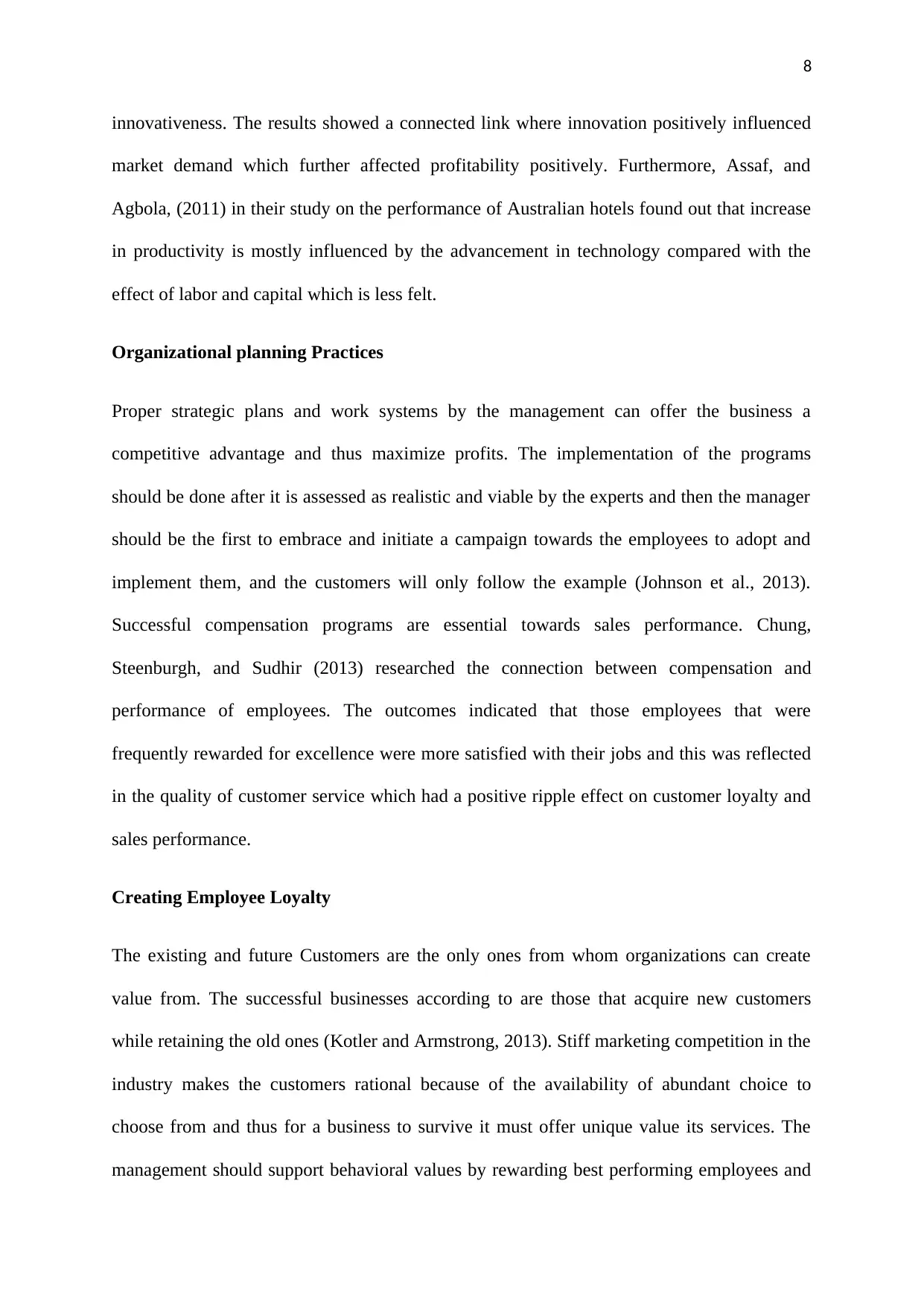
8
innovativeness. The results showed a connected link where innovation positively influenced
market demand which further affected profitability positively. Furthermore, Assaf, and
Agbola, (2011) in their study on the performance of Australian hotels found out that increase
in productivity is mostly influenced by the advancement in technology compared with the
effect of labor and capital which is less felt.
Organizational planning Practices
Proper strategic plans and work systems by the management can offer the business a
competitive advantage and thus maximize profits. The implementation of the programs
should be done after it is assessed as realistic and viable by the experts and then the manager
should be the first to embrace and initiate a campaign towards the employees to adopt and
implement them, and the customers will only follow the example (Johnson et al., 2013).
Successful compensation programs are essential towards sales performance. Chung,
Steenburgh, and Sudhir (2013) researched the connection between compensation and
performance of employees. The outcomes indicated that those employees that were
frequently rewarded for excellence were more satisfied with their jobs and this was reflected
in the quality of customer service which had a positive ripple effect on customer loyalty and
sales performance.
Creating Employee Loyalty
The existing and future Customers are the only ones from whom organizations can create
value from. The successful businesses according to are those that acquire new customers
while retaining the old ones (Kotler and Armstrong, 2013). Stiff marketing competition in the
industry makes the customers rational because of the availability of abundant choice to
choose from and thus for a business to survive it must offer unique value its services. The
management should support behavioral values by rewarding best performing employees and
innovativeness. The results showed a connected link where innovation positively influenced
market demand which further affected profitability positively. Furthermore, Assaf, and
Agbola, (2011) in their study on the performance of Australian hotels found out that increase
in productivity is mostly influenced by the advancement in technology compared with the
effect of labor and capital which is less felt.
Organizational planning Practices
Proper strategic plans and work systems by the management can offer the business a
competitive advantage and thus maximize profits. The implementation of the programs
should be done after it is assessed as realistic and viable by the experts and then the manager
should be the first to embrace and initiate a campaign towards the employees to adopt and
implement them, and the customers will only follow the example (Johnson et al., 2013).
Successful compensation programs are essential towards sales performance. Chung,
Steenburgh, and Sudhir (2013) researched the connection between compensation and
performance of employees. The outcomes indicated that those employees that were
frequently rewarded for excellence were more satisfied with their jobs and this was reflected
in the quality of customer service which had a positive ripple effect on customer loyalty and
sales performance.
Creating Employee Loyalty
The existing and future Customers are the only ones from whom organizations can create
value from. The successful businesses according to are those that acquire new customers
while retaining the old ones (Kotler and Armstrong, 2013). Stiff marketing competition in the
industry makes the customers rational because of the availability of abundant choice to
choose from and thus for a business to survive it must offer unique value its services. The
management should support behavioral values by rewarding best performing employees and
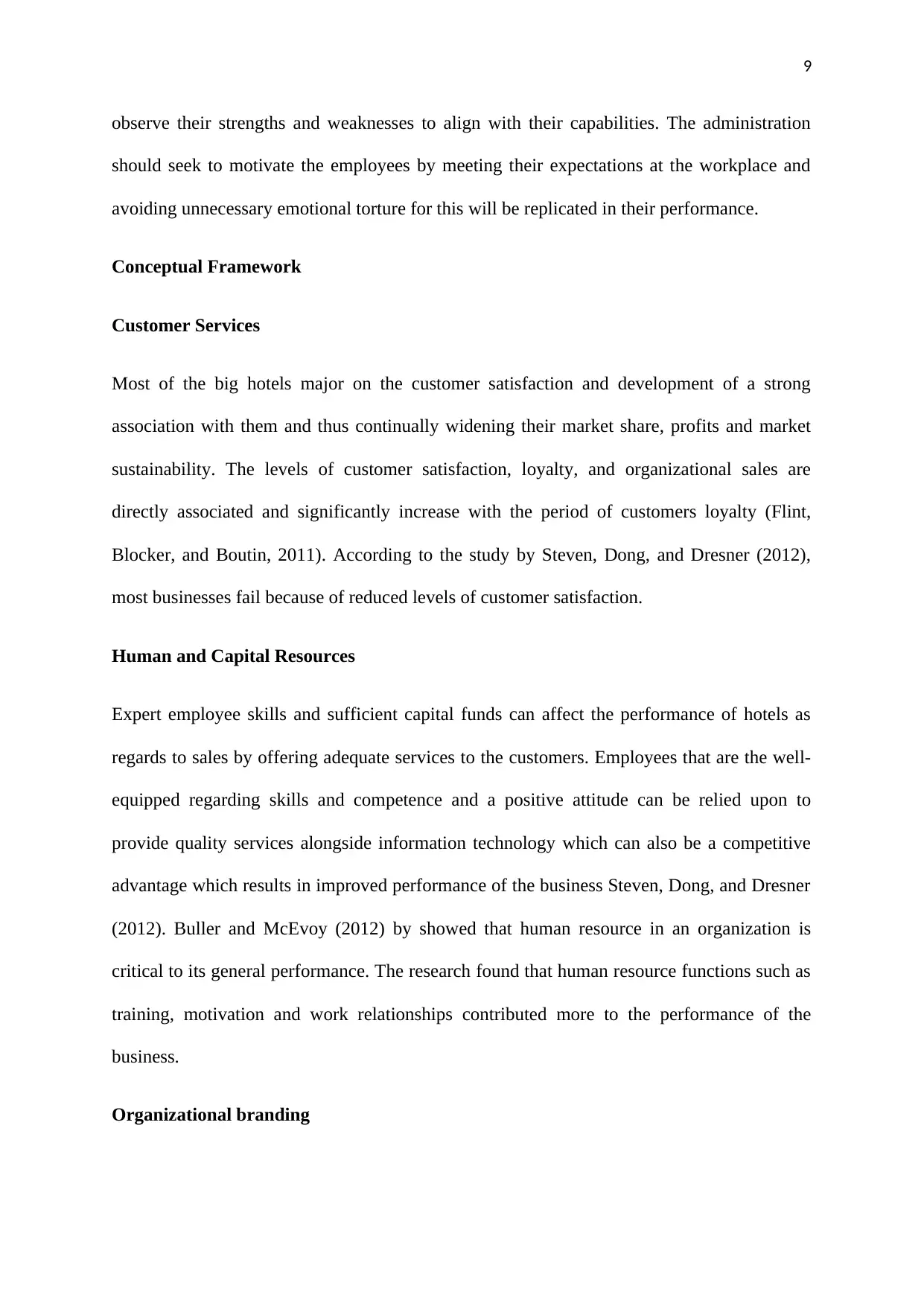
9
observe their strengths and weaknesses to align with their capabilities. The administration
should seek to motivate the employees by meeting their expectations at the workplace and
avoiding unnecessary emotional torture for this will be replicated in their performance.
Conceptual Framework
Customer Services
Most of the big hotels major on the customer satisfaction and development of a strong
association with them and thus continually widening their market share, profits and market
sustainability. The levels of customer satisfaction, loyalty, and organizational sales are
directly associated and significantly increase with the period of customers loyalty (Flint,
Blocker, and Boutin, 2011). According to the study by Steven, Dong, and Dresner (2012),
most businesses fail because of reduced levels of customer satisfaction.
Human and Capital Resources
Expert employee skills and sufficient capital funds can affect the performance of hotels as
regards to sales by offering adequate services to the customers. Employees that are the well-
equipped regarding skills and competence and a positive attitude can be relied upon to
provide quality services alongside information technology which can also be a competitive
advantage which results in improved performance of the business Steven, Dong, and Dresner
(2012). Buller and McEvoy (2012) by showed that human resource in an organization is
critical to its general performance. The research found that human resource functions such as
training, motivation and work relationships contributed more to the performance of the
business.
Organizational branding
observe their strengths and weaknesses to align with their capabilities. The administration
should seek to motivate the employees by meeting their expectations at the workplace and
avoiding unnecessary emotional torture for this will be replicated in their performance.
Conceptual Framework
Customer Services
Most of the big hotels major on the customer satisfaction and development of a strong
association with them and thus continually widening their market share, profits and market
sustainability. The levels of customer satisfaction, loyalty, and organizational sales are
directly associated and significantly increase with the period of customers loyalty (Flint,
Blocker, and Boutin, 2011). According to the study by Steven, Dong, and Dresner (2012),
most businesses fail because of reduced levels of customer satisfaction.
Human and Capital Resources
Expert employee skills and sufficient capital funds can affect the performance of hotels as
regards to sales by offering adequate services to the customers. Employees that are the well-
equipped regarding skills and competence and a positive attitude can be relied upon to
provide quality services alongside information technology which can also be a competitive
advantage which results in improved performance of the business Steven, Dong, and Dresner
(2012). Buller and McEvoy (2012) by showed that human resource in an organization is
critical to its general performance. The research found that human resource functions such as
training, motivation and work relationships contributed more to the performance of the
business.
Organizational branding
⊘ This is a preview!⊘
Do you want full access?
Subscribe today to unlock all pages.

Trusted by 1+ million students worldwide
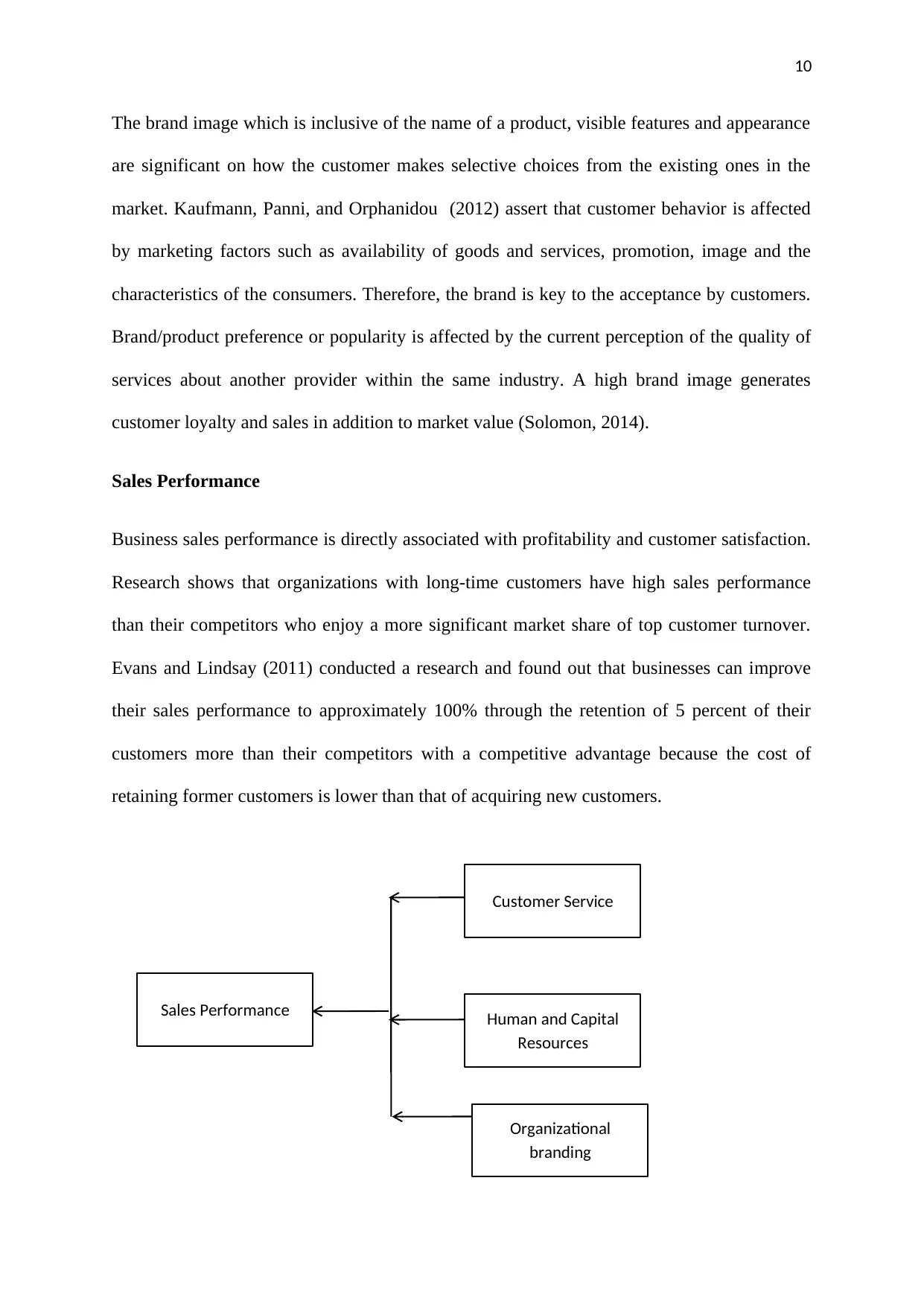
10
The brand image which is inclusive of the name of a product, visible features and appearance
are significant on how the customer makes selective choices from the existing ones in the
market. Kaufmann, Panni, and Orphanidou (2012) assert that customer behavior is affected
by marketing factors such as availability of goods and services, promotion, image and the
characteristics of the consumers. Therefore, the brand is key to the acceptance by customers.
Brand/product preference or popularity is affected by the current perception of the quality of
services about another provider within the same industry. A high brand image generates
customer loyalty and sales in addition to market value (Solomon, 2014).
Sales Performance
Business sales performance is directly associated with profitability and customer satisfaction.
Research shows that organizations with long-time customers have high sales performance
than their competitors who enjoy a more significant market share of top customer turnover.
Evans and Lindsay (2011) conducted a research and found out that businesses can improve
their sales performance to approximately 100% through the retention of 5 percent of their
customers more than their competitors with a competitive advantage because the cost of
retaining former customers is lower than that of acquiring new customers.
Sales Performance
Organizational
branding
Human and Capital
Resources
Customer Service
The brand image which is inclusive of the name of a product, visible features and appearance
are significant on how the customer makes selective choices from the existing ones in the
market. Kaufmann, Panni, and Orphanidou (2012) assert that customer behavior is affected
by marketing factors such as availability of goods and services, promotion, image and the
characteristics of the consumers. Therefore, the brand is key to the acceptance by customers.
Brand/product preference or popularity is affected by the current perception of the quality of
services about another provider within the same industry. A high brand image generates
customer loyalty and sales in addition to market value (Solomon, 2014).
Sales Performance
Business sales performance is directly associated with profitability and customer satisfaction.
Research shows that organizations with long-time customers have high sales performance
than their competitors who enjoy a more significant market share of top customer turnover.
Evans and Lindsay (2011) conducted a research and found out that businesses can improve
their sales performance to approximately 100% through the retention of 5 percent of their
customers more than their competitors with a competitive advantage because the cost of
retaining former customers is lower than that of acquiring new customers.
Sales Performance
Organizational
branding
Human and Capital
Resources
Customer Service
Paraphrase This Document
Need a fresh take? Get an instant paraphrase of this document with our AI Paraphraser
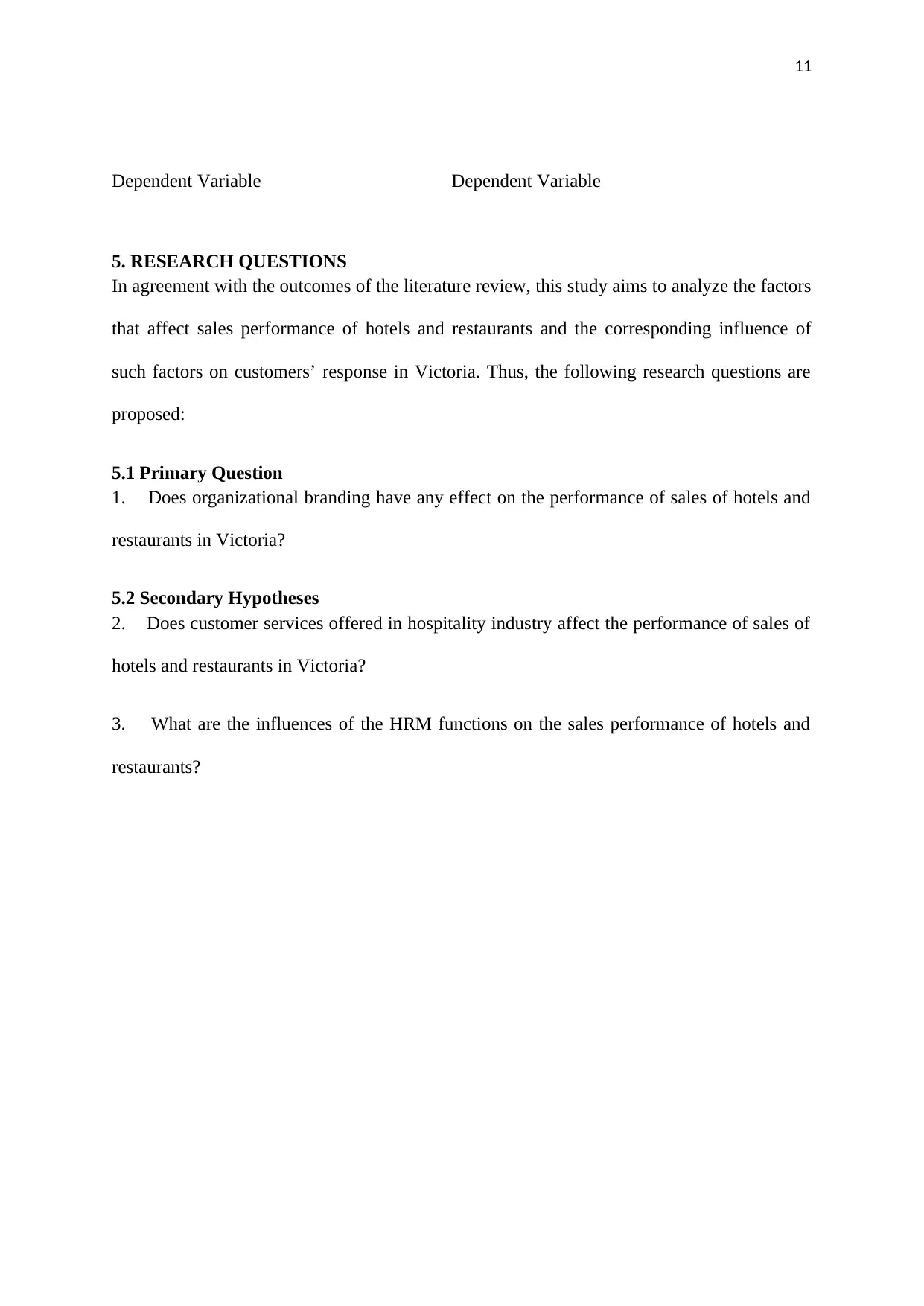
11
Dependent Variable Dependent Variable
5. RESEARCH QUESTIONS
In agreement with the outcomes of the literature review, this study aims to analyze the factors
that affect sales performance of hotels and restaurants and the corresponding influence of
such factors on customers’ response in Victoria. Thus, the following research questions are
proposed:
5.1 Primary Question
1. Does organizational branding have any effect on the performance of sales of hotels and
restaurants in Victoria?
5.2 Secondary Hypotheses
2. Does customer services offered in hospitality industry affect the performance of sales of
hotels and restaurants in Victoria?
3. What are the influences of the HRM functions on the sales performance of hotels and
restaurants?
Dependent Variable Dependent Variable
5. RESEARCH QUESTIONS
In agreement with the outcomes of the literature review, this study aims to analyze the factors
that affect sales performance of hotels and restaurants and the corresponding influence of
such factors on customers’ response in Victoria. Thus, the following research questions are
proposed:
5.1 Primary Question
1. Does organizational branding have any effect on the performance of sales of hotels and
restaurants in Victoria?
5.2 Secondary Hypotheses
2. Does customer services offered in hospitality industry affect the performance of sales of
hotels and restaurants in Victoria?
3. What are the influences of the HRM functions on the sales performance of hotels and
restaurants?
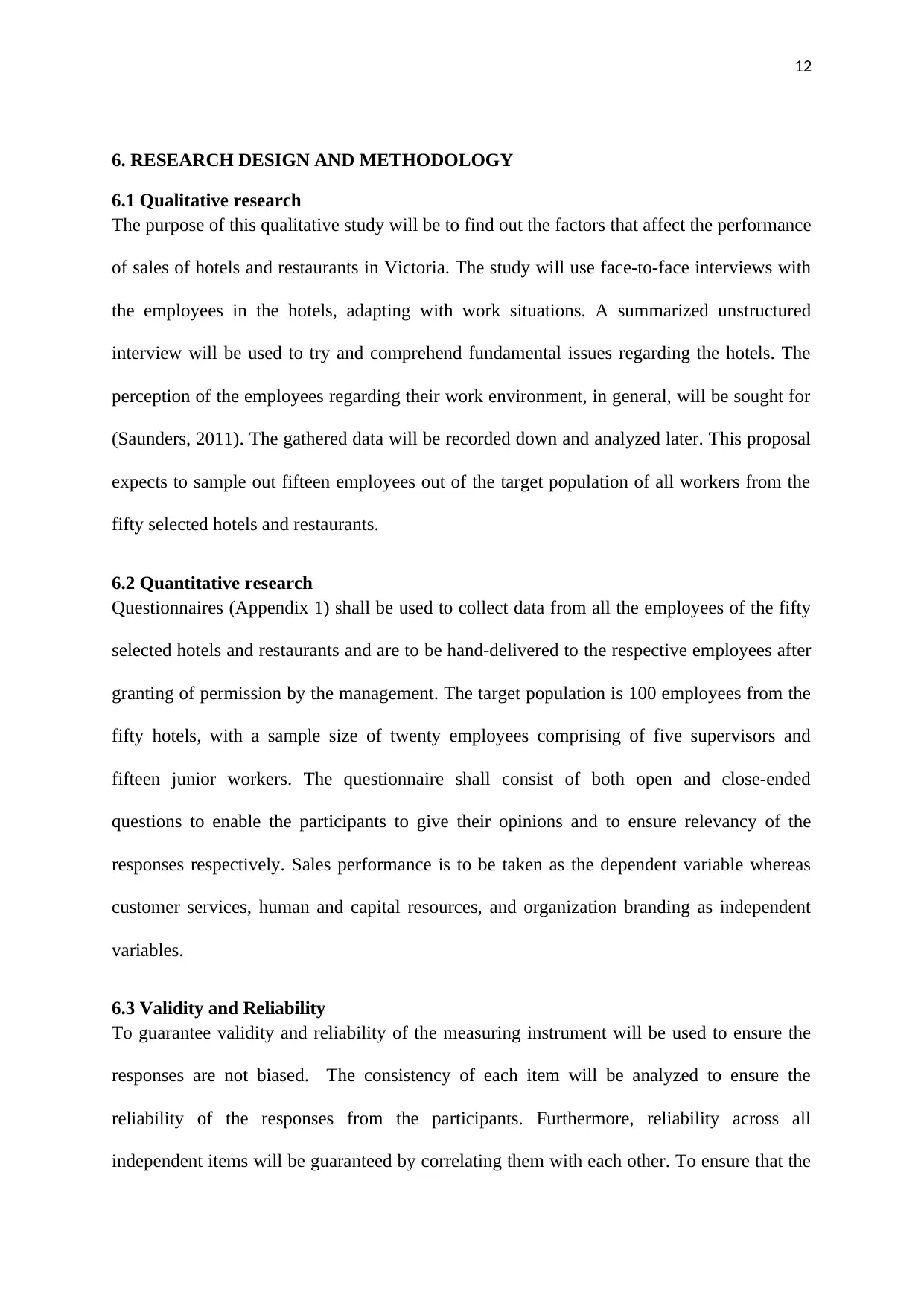
12
6. RESEARCH DESIGN AND METHODOLOGY
6.1 Qualitative research
The purpose of this qualitative study will be to find out the factors that affect the performance
of sales of hotels and restaurants in Victoria. The study will use face-to-face interviews with
the employees in the hotels, adapting with work situations. A summarized unstructured
interview will be used to try and comprehend fundamental issues regarding the hotels. The
perception of the employees regarding their work environment, in general, will be sought for
(Saunders, 2011). The gathered data will be recorded down and analyzed later. This proposal
expects to sample out fifteen employees out of the target population of all workers from the
fifty selected hotels and restaurants.
6.2 Quantitative research
Questionnaires (Appendix 1) shall be used to collect data from all the employees of the fifty
selected hotels and restaurants and are to be hand-delivered to the respective employees after
granting of permission by the management. The target population is 100 employees from the
fifty hotels, with a sample size of twenty employees comprising of five supervisors and
fifteen junior workers. The questionnaire shall consist of both open and close-ended
questions to enable the participants to give their opinions and to ensure relevancy of the
responses respectively. Sales performance is to be taken as the dependent variable whereas
customer services, human and capital resources, and organization branding as independent
variables.
6.3 Validity and Reliability
To guarantee validity and reliability of the measuring instrument will be used to ensure the
responses are not biased. The consistency of each item will be analyzed to ensure the
reliability of the responses from the participants. Furthermore, reliability across all
independent items will be guaranteed by correlating them with each other. To ensure that the
6. RESEARCH DESIGN AND METHODOLOGY
6.1 Qualitative research
The purpose of this qualitative study will be to find out the factors that affect the performance
of sales of hotels and restaurants in Victoria. The study will use face-to-face interviews with
the employees in the hotels, adapting with work situations. A summarized unstructured
interview will be used to try and comprehend fundamental issues regarding the hotels. The
perception of the employees regarding their work environment, in general, will be sought for
(Saunders, 2011). The gathered data will be recorded down and analyzed later. This proposal
expects to sample out fifteen employees out of the target population of all workers from the
fifty selected hotels and restaurants.
6.2 Quantitative research
Questionnaires (Appendix 1) shall be used to collect data from all the employees of the fifty
selected hotels and restaurants and are to be hand-delivered to the respective employees after
granting of permission by the management. The target population is 100 employees from the
fifty hotels, with a sample size of twenty employees comprising of five supervisors and
fifteen junior workers. The questionnaire shall consist of both open and close-ended
questions to enable the participants to give their opinions and to ensure relevancy of the
responses respectively. Sales performance is to be taken as the dependent variable whereas
customer services, human and capital resources, and organization branding as independent
variables.
6.3 Validity and Reliability
To guarantee validity and reliability of the measuring instrument will be used to ensure the
responses are not biased. The consistency of each item will be analyzed to ensure the
reliability of the responses from the participants. Furthermore, reliability across all
independent items will be guaranteed by correlating them with each other. To ensure that the
⊘ This is a preview!⊘
Do you want full access?
Subscribe today to unlock all pages.

Trusted by 1+ million students worldwide
1 out of 22
Related Documents
Your All-in-One AI-Powered Toolkit for Academic Success.
+13062052269
info@desklib.com
Available 24*7 on WhatsApp / Email
![[object Object]](/_next/static/media/star-bottom.7253800d.svg)
Unlock your academic potential
Copyright © 2020–2025 A2Z Services. All Rights Reserved. Developed and managed by ZUCOL.




